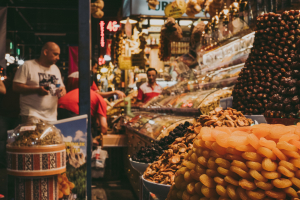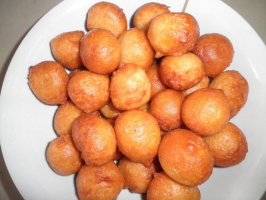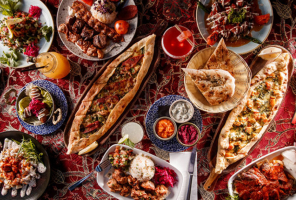Top 12 Best Dutch Foods
Due to its simplicity and rustic nature, Dutch cuisine may not be as well-known as other European cuisines. Dutch cuisine, on the other hand, is really ... read more...excellent. There are also many regional specialties to sample during your visit! Let's take a look at some of the best, from sweet to savory!
-
Speculoos, also known as Speculaas, is a spiced biscuit that is typically cooked around St Nicholas Day in the Netherlands on the 5th of December. Shortbread biscuits are frequently decorated with images of a ship, elephant, farmhouse, horse, or other aspects from the St. Nicholas myth. The name of the biscuit could be derived from the Latin word speculator, which means "one who sees everything," which was St Nicholas' title. It could also have been derived from the Dutch word 'specerij' which means spice.
With traces of cardamom, nutmeg, cinnamon, cloves, or ginger, the thin, crunchy biscuits are prepared. The Dutch enjoy Speculoos so much that they've made their own versions, including those with anise or almond flour.
The best aspect about Speculoos, though, is that it can be used as a bread spread. This variant of the cookie butter is created with 60% crushed Speculoos cookies and is known as Speculoos, Speculla, or Biskoff Spread. Els Scheppers of the popular Belgian TV show "De Bedenkers" popularized the caramelized ginger flavor (The Inventors).

commons.wikimedia.org 
tbcc.vn -
These spicy little biscuits, which literally translate as "pepper nuts," arose in the 16th century when spices became more available in Europe as a result of commerce with the Far East. Cookies prepared with rye flour, anise, and sugar, flavored with cinnamon or cloves, became connected with Sinterklaas Day on December 5th.
On Sinterklaas day, Saint Nikolas is said to arrive by boat from Spain. He would leave gold money in the shoes of individuals who had left them out for him, as well as gifts for the youngsters. Saint Nick also tossed gold coins through the windows of three young girls' homes as a dowry. Since then, these oddly shaped cookies have been dropped in handfuls in children's rooms to encourage them to hunt for them on Sinterklaas day. What a strange custom!
While historic pepernoten were circular in shape and commonly confused with Kruidnoten, which are also created for Sinterklass day, modern-day pepernoten are round in shape. These cookies have a half-sphere form, are hard and crunchy, and have a speculoos-like flavor.

thespruceeats.com 
cookpad.com -
The Ontbijtkoek is a delectable ginger-spiced rye flour cake. Ginger, cloves, cinnamon, and nutmeg are among the spices utilized. Succade, a candied citrus peel, is sometimes used as well. The recipe changes depending on where you are in the Netherlands. Ontbijtkoek, which literally translates as 'morning cake,' is a must-have for breakfast or as a snack with a thick layer of butter on top.
Is it true that ontbijtkoek is a Dutch cake? It is debatable. Pepper was used in the ancient Egyptians, Greeks, and Romans' breakfast cakes. The cake was traditionally created with leftover bread and various spices in the Middle Ages. Many bakeries around the Netherlands began to create the cake in the 16th century, employing ginger and other spices.
Peperkoek (pepper cake) and kruidkoek are other names for Ontbijtkoek (spicy cake). If you intend to travel to the Netherlands, Ontbijtkoek (Peperkoek or Kruidkoek) is one of the must-try foods for you.

cdkitchen.com 
worldfood.guide -
Bitterballen are very similar to krokets, with the exception of their shape. Bitterballen are small and round where the kroket is narrow and long. In 18th-century Amsterdam, a pub owner named Jan Barentz was looking for some finger food to feed his thirsty customers. His wife crumbled leftover croquettes and rolled them in eggs and breadcrumbs before deep-frying them in hot oil. And they quickly rose to prominence!
Bitterballen is a traditional Dutch dish that can be found in almost any bar. They're usually ordered or served as snacks with drinks, and they're not bitter at all! These small, fried, bread-crumbed balls are stuffed with a veal and beef ragout and served with mustard. They're usually very hot on the inside, so wait a few moments after you get them and never put a whole ball in your mouth at once, or you'll burn your tongue. If you intend to travel to the Netherlands, Bitterballen is one of the must-try foods for you.

learndutch.org 
discoverbenelux.com -
In the Netherlands, the most popular market snack is kibbeling. The Dutch version of fish and chips is fried battered fish (usually cod or ray-finned whiting) with tartar sauce. The term kibbeling usually referred to cod cheeks, which were a staple of the Dutch diet in the nineteenth century. Previously, it referred to the waste parts of a fish, including the head, that were usually given to the poor, but by 1849, it only referred to the cheeks of the cod. In the 1950s, a fishmonger from IJmuiden had the brilliant idea of breading cod cheeks and selling them to tourists as a snack. And it quickly became popular.
Lekkerbekje is a type of kibbeling that has not been cut into pieces. It's typically served with patatje oorlog, which are thickly fried fries topped with mayonnaise. While you enjoy kibbeling, fried mussels seem to taste better, which are available in the same stalls as the kibbeling. Lots of people have never considered eating fried mussels, let alone battered ones, but they are delicious.

foodieadvice.com 
https://annaeverywhere.com/ -
Gouda Holland is a semi-hard Dutch cheese made entirely from cows' milk from Dutch farms, and it is one of the world's most popular cheeses. Depending on the stage of maturity, the cheese is made in a flattened wheel shape and is flavorful and aromatic (mild, fruity, sweet, butterscotch flavors).
Young Gouda has a sweet, fruity flavor, but as it ages, it turns a deep yellow and becomes firmer, almost granular. It has a complex flavor that ranges from fruity notes to hints of cocoa and groundnut, leaving a rich and smooth aftertaste in the mouth. It is usually served sliced in sandwiches or cut into cubes as a snack. Young Gouda is delicious in sandwiches, snacks, and salads. Aged Gouda pairs well with strong pale beers like Tripel, Dubbel, or Trappist, while wine enthusiasts can pair the cheese with a glass of Pinot Noir or Barolo.
The longer it is aged, the more caramel and butterscotch flavor it develops, as well as its crunchy texture. It is a Protected Geographical Indications (PGI) cheese, which means it is made in Holland using traditional methods and milk from Dutch cows. It has a minimum fat content of 48 percent in dry matter.

oldamsterdamcheesestore.com 
theculturetrip.com -
Kroket is a modern Dutch counterpart to classic French croquettes, consisting of chilled ingredients such as meat, seafood, cheese, and gravy that are rolled into logs, breaded, and deep-fried until golden brown.
The most traditional Dutch kroket is made with meat ragout and breadcrumbs. The oldest recipe for the Dutch kroket is thought to date back to 1830, and it has appeared in numerous Dutch cookbooks since then. Kroket was originally served as a side dish, but after WWII, it quickly became a popular snack item.
Kroketten are now available in a croquette sandwich or with French fries, and come in a variety of flavors such as goulash kroket, prawn kroket, and vegetarian kroket. There's also the bitterbal, a small, round-shaped version of kroket made with beef or veal that's a popular snack in Dutch bars. If you intend to travel to the Netherlands, Kroket is one of the must-try foods for you.

https://www.tasteatlas.com/ 
https://www.tasteatlas.com/ -
Appeltaart is a traditional Dutch apple pie that is frequently served with a cup of hot coffee. Although it is essentially the same as most apple pies, Dutch appeltaart differs from the classic American apple pie in several ways: it is baked in a spring-form pan, which makes it deeper; it is drier on the inside; it is full of big chunks of apple, currants, and raisins; and it is full of speculoos spices such as cinnamon, lemon juice, and other warm spices.
Appeltaart dates back to the Middle Ages, and it is believed that the baking time was determined by the number of prayers said until it was ready to be removed from the oven, as ovens with temperature controls did not exist at the time. In the Netherlands, appeltaart is typically served at room temperature with a dollop of whipped cream on top, a dish known as appeltaart met slagroom.
This traditional dessert is one of the first pies that young people learn to make in the Netherlands, but grandmas are said to make the best ones.

https://www.tasteatlas.com/ 
https://www.tasteatlas.com/ -
Kapsalon is a popular Dutch street food dish that consists of French fries topped with shawarma or kebab, various types of cheese (typically Gouda), salad greens, and various sauces (typically garlic sauce). Kapsalon is a perfect example of how culinary traditions from different parts of the world can combine to create a favorite meal. It is filling, practical, and influenced by various national cuisines. This dish unquestionably qualifies as fast food, with one serving containing approximately 1800 calories.
There is a vegetarian version of the dish that uses falafel instead of meat. The term kapsalon (Dutch for barbershop) is thought to have originated in Rotterdam around 2003, when a barber went to a nearby fast food restaurant and ordered a meal of French fries and shawarma.
The owner of the fast-food restaurant suggested adding tomatoes, lettuce, and cheese on top, and kapsalon was born, its popularity quickly spreading throughout the country. Although it is flavorful and comforting, kapsalon is a high-calorie dish that should be consumed in moderation.

https://www.tasteatlas.com/ 
en.wikipedia.org -
Poffertjes are Dutch pancakes that are small, round, and puffy, made with yeast and buckwheat flour. When prepared outdoors, at festivals and outdoor events, they are baked in a special pan called a poffertjespan and served warm on a piece of cardboard paper. They are typically consumed as a snack and are rarely consumed for breakfast. Poffertjes are traditionally topped with melted butter and powdered sugar, but there are a variety of non-traditional toppings available, such as whipped cream, fresh fruit, or rum.
During the Christmas and New Year holidays, poffertjes can be found at a variety of street carts throughout the Netherlands. Poffertjes are thought to have originated in a Dutch Abbey, where they were used as a type of communion host. Poffertjes became very popular after churchgoers tried them and liked them, so local stallholders seized the opportunity and began selling them as snacks.
The first recipe for poffertjes was discovered in a mid-1700s cookbook, when the dish was considered a poor man's meal. Poffertjes are now a standard at most Dutch weddings, birthday parties, and other festive occasions.

https://www.tasteatlas.com/ 
https://www.tasteatlas.com/ -
Stamppot, which translates to "mashed pot," is a traditional Dutch dish made with mashed potatoes and one or more vegetables such as kale, spinach, endive, turnip, or sauerkraut. When potatoes are mashed with onions and carrots, the dish is known as hutspot.
In addition to stamppot, bacon can be used as an accompaniment, but it is usually served on the side with smoked sausage or cooked meat. Stamppot boerenkool, which consists of potatoes mashed with kale, is the most popular type of stamppot. It is a dish that is commonly served in restaurants and at street fairs, providing some warmth on cold, foggy, and grey winter days. The kale variety is ideal for the winter season because the kale leaves are best when frosted, and the cold tenderizes and improves the flavor.
The dish, however, can also be made at home. To enhance the flavors, the vegetables are cut and boiled in a pot. Once cooked, the water is drained and the vegetables are mashed together with butter, salt, pepper, and parsley.

https://www.tasteatlas.com/ 
heavenly-holland.com -
Pannekoek is a type of Dutch pancake that is thicker than American pancakes but thinner than crêpes. It is made using milk, flour, salt, and eggs. Pannekoeken are typically served for supper, lunch, or dessert in the Netherlands, but not for breakfast.
They're usually served with molasses syrup (stroop), sugar, apples, and cinnamon, although some cooks like to add bacon and cheese to plain pancakes for a full meal. In Belgium and South Africa, pannekoeken are commonly served with cinnamon sugar and a solitary lemon wedge.
When it's cold and raining outside, South Africans love to eat pancakes so much that the cold, damp weather is dubbed "pancake-weather" in the country. If you intend to travel to the Netherlands, Pannekoek is one of the must-try foods for you.

https://www.tasteatlas.com/ 
https://www.tasteatlas.com/

































